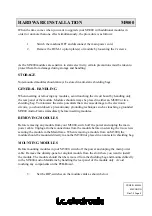
LFS4100
Chapter 6: Fusion Splicing
Page 28
TTN047498-D01
Normally after the “Lens Left” process, a sequence such as, “Auto Exposure,” “End View Focus,” “Auto
Exposure,” and then “End View Process,” would be inserted to align the fiber. If the operator is unhappy with the
alignment, the process can be stopped and the fibers can be manually aligned.
Table 3: PM Fiber Parameters
Note that “OD Ratio” represents the fraction of the fiber diameter which will be used to calculate the fiber end
angle. It is the fraction of the fiber diameter that contains the PM Structure.
6.3.4. Active XY Alignment
The active alignment method should be used for fiber that has a high core eccentricity. In this case, the edge
alignment method cannot ensure proper alignment of the fiber cores. Active alignment is a core-to-core alignment
which uses output from an optical power meter to maximize the power transmission. Active alignment is
implemented by performing the “Active Alignment” process after an “Align” process has been completed. The
process first moves one fiber away from the aligned position and then back towards the stationary fiber to
eliminate the motor backlash. A reference power meter reading is taken at this position. The fiber is then moved
by a given scan step size and another power meter reading is taken. This continues until the fiber has scanned
through the maximum power. The fiber is then driven back to the maximum power meter reading position.
6.4. Loss Estimation
The LFS4100 can estimate the optical loss caused by a splice by analyzing the image captured
by the CCD camera. To do loss estimation at the end of a splice, click the Loss Estimation button
on the main toolbar. The loss estimation process must be calibrated for the fiber type and
wavelength.
The calibration data for the loss estimation process takes the form of a number of coefficients that are generated
by contrasting the actual measured loss of a splice with the core perturbations detected during the loss estimation
process. Calibration is performed by selecting the “Calibrate” feature in the loss estimation process. This instructs
the loss estimation process to save a data set for each splice. This data set must include the actual splice loss,
which must then be entered by the operator. All of this data is saved into a file called “power_spectrum.txt,” which
is appended with data from every splice. Data from at least 20 splices is required for a sensible calibration. The
“power_Spectrum.txt” file should be sent to Thorlabs to generate the calibration coefficients.
6.5. Filament Normalization
Before using a new filament and when starting the equipment after a long period of inactivity it is necessary to
perform filament normalization. This will adjust some parameters to ensure a high quality splice. Two key control
parameters are the “view to splice distance” (to center the filament between the fibers) and the “power offset” (to
have the same temperature).
In the filament normalization process, the fibers are heated without a hot push. This process burns back both fiber
ends. The software then measures the level of regression of each fiber and compares it with a predefined value.
The “view to splice distance” and filament “power offset” are then changed and reported by the software.
Fiber Type
Parameter 1
Parameter 2
Generic
OD Ratio
N/A
Panda
Core Center to Stress Rod
Center, (Pixels)
Stress Rod Diameter
(Pixels)
Elliptical (3M)
Core Center to Edge of Ellipse,
Minor diameter (Pixels)
Core Center to Edge of Ellipse,
Major Diameter (Pixels)
Bow Tie (Fiber Core)
Core Center to Stress Rod
Center (Pixels)
N/A
Содержание Vytran LFS4100
Страница 1: ...LFS4100 Fiber Splicer User Guide...
Страница 44: ...www thorlabs com...














































